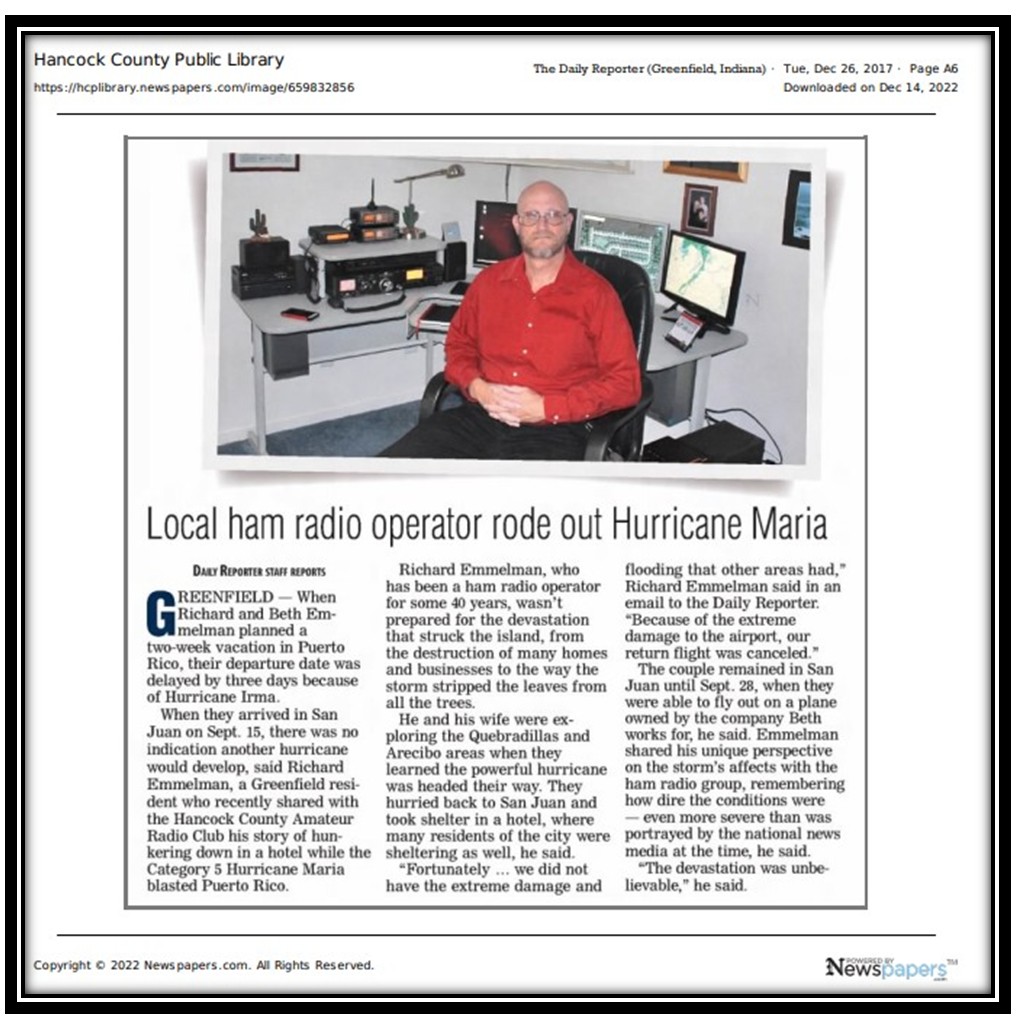W9ATG
| Year Acquired | License Holder | Location |
|---|---|---|
| 1921 | Maynard R. Briggs | St. Paul, MN |
| 1924 | Earl Beckwith | Pleasantville, IA |
| 1925 | Joseph Lesmeister | Harvey, ND |
| 1926 | Phillip E. Haller | Chicago, IL |
| 1931 | Leslie R. Matson | Fort Dodge, KS |
| 1940 | Charles L. Corderman | Waterloo, IA |
| 1947 | Phillip N. Macy | Greenfield, IN |
| 1961 | Hancock Amateur Radio Club | Greenfield, IN |
The W9ATG callsign was first issued in 1921 to Maynard Briggs in St. Paul, MN and it would be reassigned to six other amateur operators over the years before the club acquired it in 1961.
The last person to hold the call sign before HARC was Phillip N. Macy, a resident of Greenfield who was in a partnership with his father-in-law W.O. Pope, owner of Pope Products, a local steel fabrication facility on S. Harrison Street – now known as Custom Metal Products on E. Main Street. In February 1960 at the age of 38 Phillip passed away while at work after suffering a heart attack.
Phillip received his amateur radio license in 1947 at the age of 25 and at the time of his passing he was the President of the Hancock Amateur Radio Club. Even before the club was formed in March 1959, Phillip began offering back-to-back classes in 1953 at his home in the evenings on Jefferson Boulevard to anyone seeking a novice license. A graduate of Greenfield High School, he was also known as a semi-professional baseball pitcher in addition to being a World War II Coast Guard veteran.
As a tribute to his contributions to Amateur Radio in our community Phillips call sign was adopted by the Hancock Amateur Radio Club.
1940: This is a QSL card given by Charles L. Corderman, W9ATG to Ralph, W2NCG

March 1959: Organizational Meeting
Radio Club for Amateurs Set
Organization Meeting Wednesday, March 11
All license amateur radio operators in Hancock county are asked to attend a meeting called by Howard Grubbs, the American Radio Relay League Emergency Co-ordinator for Hancock County, Wednesday, March 11th at 7:30 p.m. in the Hoosier Soft Water Co. building, 25 E. Pierson Street, Greenfield.
The purpose of the meeting is to form a Radio Club and to organize the radio operators in the county into an Amateur Radio Emergency Corp.
There are 25 known licensed operators in the county, said Mr. Grubbs and close to a 100 percent turn out is expected.
To any persons interested who are not licensed operators, there is a code class being held at the home of Phil Macy, 77 Jefferson Blvd., Greenfield, on Tuesday evenings at 7 o’clock (DST). This class has just started and anyone wishing to learn the code is invited to attend the classes. Also interested persons are invited to attend the organization meeting, Mr. Grubbs stated.
Amateur radio operators are noted for the services they render in many cases of emergency throughout the country. There have been innumerable times when a stricken community has had no other means of communication with the outside world except by the licensed operators, also the continued experimentations have helped lead the fast growth of radio communications.
March 1959: Club Formation
Amateur Radio Club Organized
Officers Elected At First Meeting
An amateur radio club with twenty charter members to be known as the Hancock Amateur Radio Club has recently been organized in Hancock County, the purpose of which is to unite the amateur operators in this community and to form a group of trained operators and technicians that will be able to set up communications in this county in case of and emergency such as hit central Illinois this past winter.
April 1959: Constitution Reviewed
Amateur Radio Club Organizes
Constitution and Business Talked
The newly organized Hancock Amateur Radio Club was called to order by its president, Howard Grubs, W9DZC, for its regular meeting Monday night, April 13th at the Hoosier Soft Water Company building at 25 E. Pierson Street, in Greenfield with a good crowd in attendance.
Among the visitors present were Cliff Singer, W9SWD, the assistant director of the Central Division of the American Radio Relay League and Dean Townsend, K9JGJ, president of the Western Electric Amateur Radio Club.
Since the club was just recently organized, this meeting was mostly taken up by the reading of the constitution and other pressing business.
Th next scheduled meeting is for Monday night, May 11, ata the same location and at this meeting it is planned to have a talk on the DX operation of an amateur radio station by Harry Franke, W9YSQ, and his son Manford, W9YSX of New Palestine. Harry and Manford are rivals in this work and there is promise of a very interesting program.
The club membership is open to all persons interested in amateur radio and your attendance is needed to boost the club’s prestige in the community.
May 1959: Hancock Civil Defense Suggests Potential Partnership with Club
Amateur Radio Club in Meet
CD Director Makes Brief Talk
The Hancock Amateur radio Club held its regular club meeting recently with 15 present. The meeting was opened with a short talk by Sam Hughes, Civil Defense Director for Hancock County, about the potentialities of the assistance that the club can give to Civil Defense in case a disaster strikes.
President Howard Grubbs (W9DZC) and Charles Haley (K9HWN) gave a short report on their attendance at the amateur get-together in Dayton, Ohio over the weekend of May 9th. This proved to be very interesting and informative.
Phil Macy (W9ATG) gave a report on the progress of his code and theory classes and advised that he has given seven or eight examinations in the past couple of months. This class affords an excellent opportunity for those interested in becoming radio amateurs to learn the fundaments of radio and to obtain their licenses. It is open to all interested persons of any age and of either sex. The class meets each Tuesday at 7 p.m. (EST) at Phil’s home. 77 Jefferson Blvd., Greenfield.
The visitor this month was Walter Foutch (W9CKX) of Pendleton. Walt is chief radio operator for the Pendleton Post of the Indiana State Police.
The next meeting will be held Monday night, June 8, at the Hoosier Soft Water Co. building at 25 East Pierson, in Greenfield. This meeting will be taken up by the annal election of officers, so it is important for all members to be there.
June 1959: Election of Officers
Amateur Radio Operators Elect
Officers Chosen for Ensuing Year
The Hancock Amateur Radio Club held its regular meeting Monday night, June 8th. with sixteen members present. The first order of business was the election of new officers for the year 1959-60.
New Officers are: Phil Macy, W9ATG, president; Howard Grubbs, W9DZC, vice president; George Clark, W0AJO. secretary; Jack Andrews, W9YWE, treasurer; Francis Richardson, W9HKZ, activites manager; and Foy Stiles, chaplin
The new meeting place for the club will be the home of Paul Macy at 77 Jefferson Blvd, commencing with July meeting.
Mr. Macy reports that the following men have taken and successfully [assed their novice examination and have received their licenses: Gale Gethers. KN9SLE; Robert Wampler, KN9SSI; Jam Frisinger, KN9SKR; and Thomas Martin, call unknown. Three other men have taken their examination but have not yet received their licenses: Steve Frazier, Thomas Freind, and Douglas Faubion.
Plans for the July meeting include a talk to be given by Walter Froutch, W9CKX, chief operator for the Pendleton State Police Post. Since this will prove to be very interesting, and exceptionally large turn out of members and interested friends is hoped for.
Remember, the July meeting will be held at the home of Phil Macy, 77 Jefferson Blvd., at 8:00pm, Monday, July 13
August 1959: Amateur Radio Club Meeting
Amateur Radio Club Meeting
The regular meeting of the Hancock Amateur Radio Club was held Monday night at the regular meeting place, 77 Jefferson Blvd., in Greenfield. Among the several business items discussed, it was decided to have a speaker at the next meeting, Sept, 14. This will be a technical discussion pertaining to radio and all interested are urged to attend. The attendance at meetings this summer is holding up very well.
Phil Macy, who has been conducting the code and theory classes for the past spring and summer, announced that he will start an new class some time in September. Those interested in attending these free classes may get in touch with Mr. Macy by phone at 77 Jefferson Blvd., and get their names on the list. Notification will be given later as to the starting date. Watch this paper for further information,
October 1959: Ham Radio Club to Aid Police
Ham Radio Club To Aid Police
Operators Volunteer Help Thru Halloween
Greenfield ham radio operators have volunteered to give an assist to city police in their intensified pre-Halloween patrols which are apparently holding down vandalism.
Police Chief Perry Easton said that at least three members of the Hancock Amateur Radio Club who have mobile two-way radios in the private automobiles will join the police patrols tonight.
Chief Easton said the HARC members will be staked out in several areas of the city in plain cars and when trouble is spotted the will radio the location to a receiver at police headquarters. The information will be quickly related to police patrols who can swoop down on vandals in almost a matter of seconds.
Officers believe the added communications system will be of real benefit to the patrols which have been successful for five holiday seasons. Police have been aided ini the patrols by volunteers from local service clubs.
Chief Easton added that so far this year there has been little real trouble with Halloween pranksters and he gives much of the credit to his helpers. There have been the usual reports of window soaping but only one case of damage,
The addition of the mobile radio patrols, he said, should give a final touch. It’ll be tough for would-be vandals to spot the private automobiles and disappear before police officers arrive to beak up trouble.
Mar 1960: Amateur Radio Club Will Meet
Amateur Radio Club Will Meet
The Hancock Amateur Radio Club will meet in regular monthly session Tuesday evening at 8:00 o’clock in the Memorial building on the second floor, southeast room.
Donald Holt of Anderson, a well known former Greenfield resident, from the Delc0-Remy plant, will be the speaker, according to an announcement from the program committee. Mr Hold will discuss “Transistors”.
The Hancock Amateur Radio Club is one year old this month and a large attendance is expected. Anyone interested in radio is invited by the club to this anniversary meeting.
Sep 1960: Class in Radio at Local Boys Club
Class in Radio at Local Boys Club
Winfred L. McFerrin, Director of the Greenfield Boys Club, announced this week the addition of a class in radio tp the Boys Club program. The first group will be formed this week and will be limited to twenty members.
The requirements for enrollment are that the boy must be a member of the club and be between the ages of 12-19.
The first session of this class will be on Sept, 27th, from 7:30 to 9:30 pm. All classes will be conducted at the Boys Club.
The class will be sponsored by the Hancock Amateur Radio Club and the instructor for the class will be Jack Andrews, president of the Hancock Amateur Radio Club. This class will provide the boys with the necessary information to become a licensed amateur. All boys interested in enrolling in this class should contact Mr. McFerrin at the club this week.
July1961: First Field Day Event
Amateur Radio Unit in First Field Day
Each year the American Radio Relay League and the Amateur Radio Emergency Corp. holds a nationwide Field Day Contest. This year the Hancock Amateur Radio Club held its first field day event June 24th and 25th on the farm of Paul :Pete: Alyea. five miles southwest of Greenfield
Two weeks of work went into the building of antennas, assembling equipment and preparing the site. During the 24-hour period four stations were in operation on four different bands, 2, 6, 40, and 75 meters. Contact was made with many stations in Indiana, across the nation, and Canada.
The purpose of this annual event is to learn to set up and maintain communications over and extended period of tie using auxiliary power independent of commercial power. The club feels they have learned a lot and are better trained to serve this county in the event of an emergency – such as last Februarys blizzard.
The club’s entire membership took part in the weekend event. They will not know how they placed in the state and national contests for about a month.
September 1961: HARC assists Parachuters Jump Here Sunday
Parachuters Jump Here Sunday
Sky Divers at Local Air Port
The Indianapolis sky Diving Club will put on an exhibition of parachute jumping at the Greenfield Airport Sunday, September 2, starting at 1:00 pm.
The members of the club are also affiliated with the Civil Defense emergency drop corps.
Also participating will be the Hancock County Rescue Unit and the Hancock Amateur Radio Club which is also a Civil Defense affiliate.
The planes carrying the jumpers will also be manned by members of the Amateur Radio Club, and it will be possible for the spectators to actually hear the conversation between the occupants of the airplane and the ground control unit. These conversations will be broadcast on the public address system so that everyone watching the exercise can hear.
The members of this club are both male and female, and some of the jumping will be done by the fairer sex.
For a never to be forgotten sight, be at the Greenfield Airport at 1:00 p.m. Sunday, September2, 1961.
January 1973 : Radio Club Active
Radio Club Active
The Hancock Amateur Radio Club was reactivated at a meeting Monday. Meetings will be conducted the second Monday of each month. The ten persons attending the meeting were Nick Gulling (WA9VLF), Paul Crawford (W9HBS). Lon Stafford (WA9TPZ), Jack Scott (K9TTL), Charles Pittinger (WD9DAG), Joe Martin (WB9GHA, Jim Apple (K9KPV), Howard Grubbs (W9DZC), B. Wampler (K9SSI), and B. Cooper (WB9HVJ)
November 1978 : Ham Radio Operators Organize
Ham Radio Operators Organize
Amateur radio operators in Hancock County are attempting to organize an emergency civil defense communication system.
Representatives et Monday night at the Red Cross office to discuss preliminary plans for organization, but attendance was light. “We have a problem in notifying all of the operators about the meetings,” said Robert Wampler, who will head the civil defense organization.
Wampler explained that books of licensed ham radio operators are listed by call letters, rather than by area or name. The books containing thousands of entries.
“We will have to come up with a list of local hams by memory”, said Wampler, “and then send out letters notifying them of the next meeting.”
Wampler estimated that there are about 50 amateur radio operators in the county.
The operators are being organized to provide a system of continuous communications in case of an emergency, such as a winter’s blizzard or a tornado. The system will be organized mainly for intra-county communications, with enough power to tie in t the Marion County Red Cross system.
The network will heave its headquarters inside the Greenfield Police station, which has an emergency generator in case of a power outage.
Organizing the civil defense network will be done in three stages, said Wampler. First, the ham radio operators will be organized.
Next, he said, the group will eet with Hancock COunty REACT to coordinate the two programs.
Finally, the equipment for the network will be set up in the basement of the Greenfield police station.
Outside of Greenfield, the communication centers will be in the local fire departments, but none of them have emergency power generators.
Beside the police station, emergency generators are at WSMJ and the Hancock County hospital,, plus several generators owned by ha operators.
The civil defense system will be coordinated closely with the Hancock County Red Cross.
September 1981: Amateur Radio Class Offered
Amateur Radio Class Offered
Hancock County Amateur Radio Club is offereing novice course in radio 7 p.m. Oct 6 in the Council Room, City Hall. Anyone interested in an amateur radio license should contact Hancocl COunty Amateur Radio Club, K9YJW, 861-5770
July 1982: Amateur Radio Club Provides Communications for Air Show
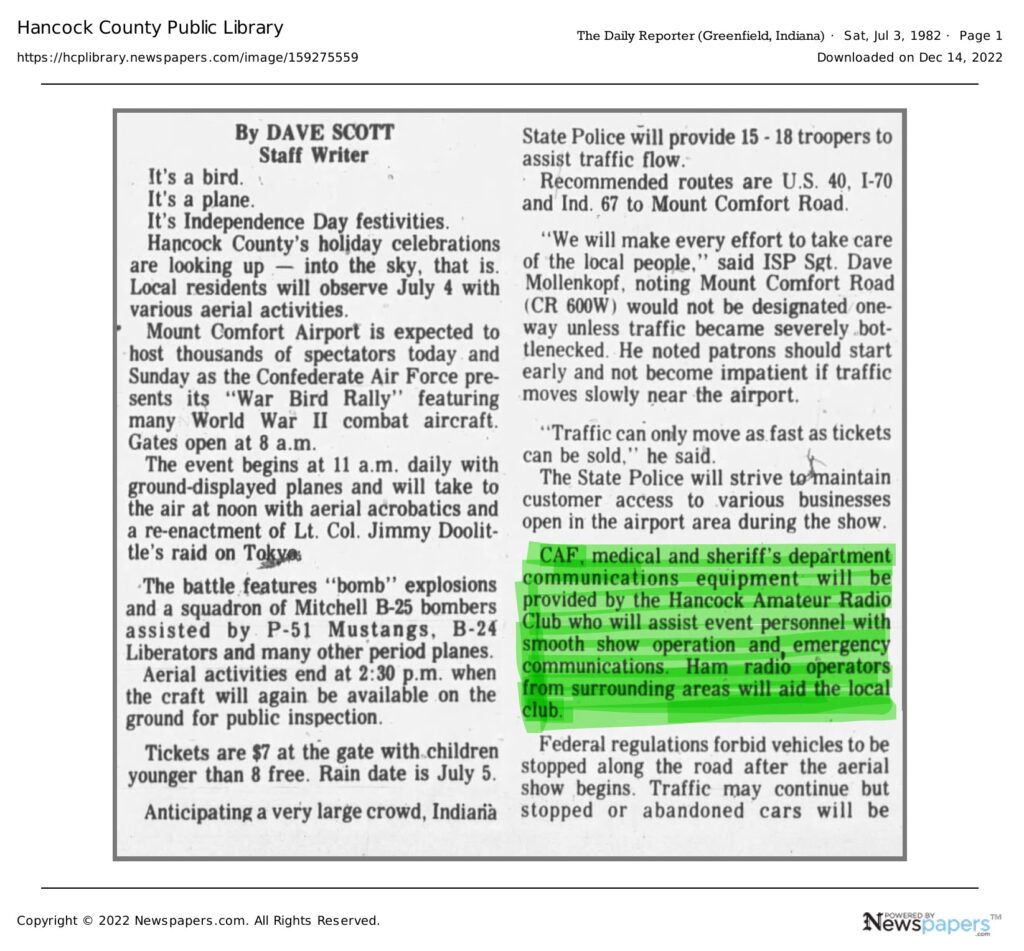
June 1983: Amateur Radio Club and Hancock County Civil Defense Practice
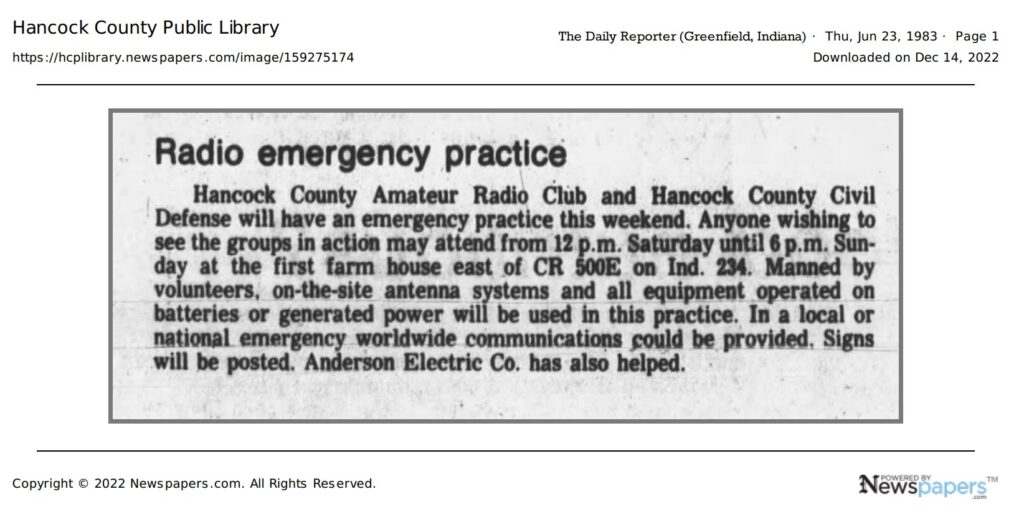
September 1983: Amateur Radio Club Receives Award
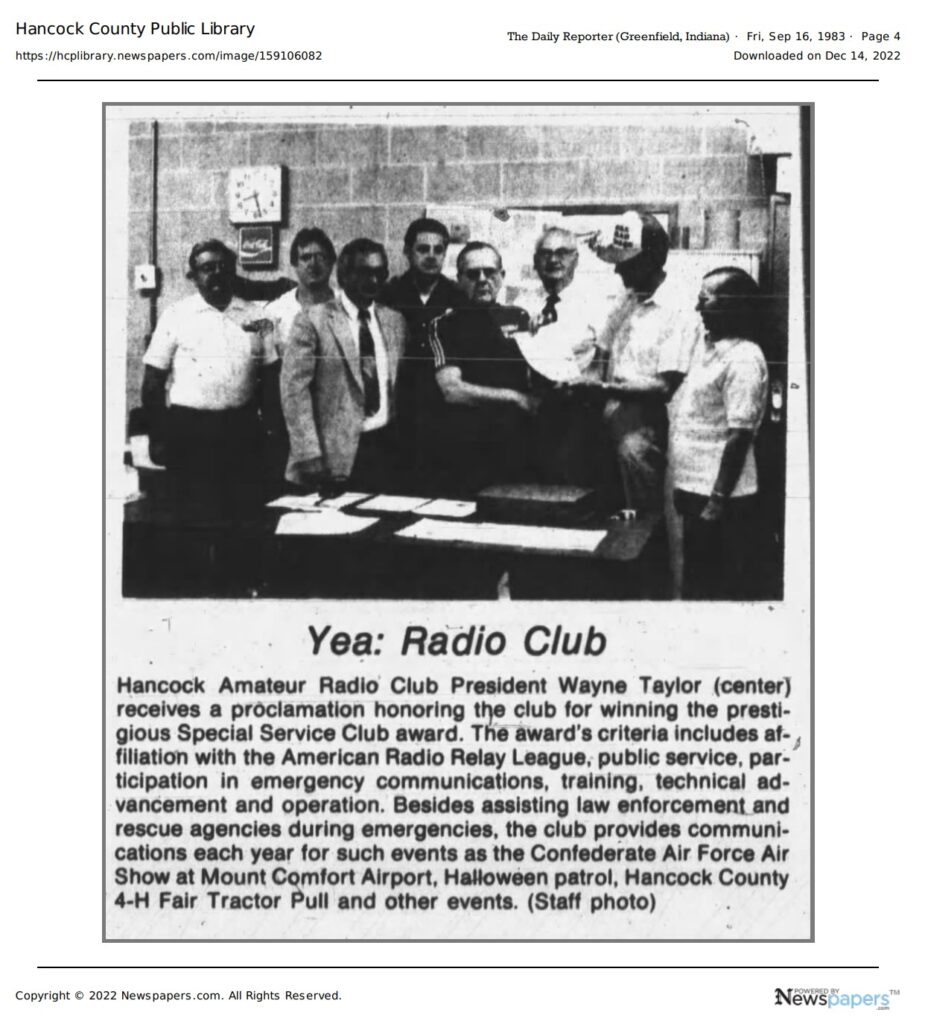
June 1999: Amateur Radio Club Testing Internationally
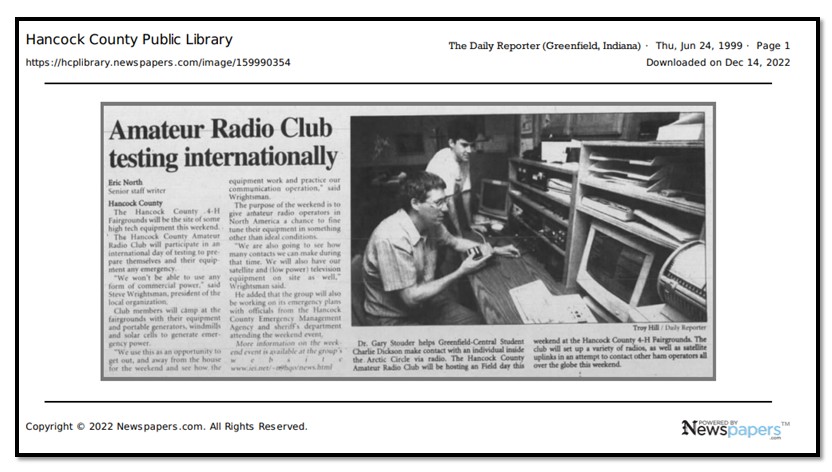
Dr. Gary Stouder helps Greenfield-Central student Charlie Dickson make contact with an individual inside the Artic Circle via radio. The Hancock County Amateur Radio Club will be hosting a Field Day this weekend at the Hancock County 4-H Fairgrounds. The club will set up a variety of radios, as well as satellite uplinks in an attempt to contact other ham operators all over the globe this weekend.
June 2000: HARC 1st Tailgate / Flea Market
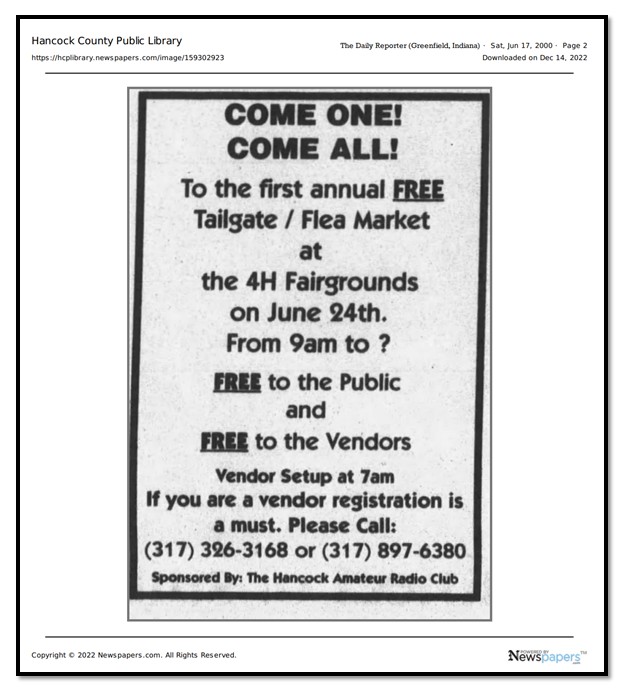
October 2001: HARC assists Greenfield Public Schools with International Space Station Contact
PUBLIC ANNOUCEMENT OF ARISS EVENT
International Space Station Contact
with Greenfield Schools
All Greenfield Central Schools will be participating in a question and answer session with an astronaut on board the International Space Station, ISS, sometime in the next 4 to6 weeks. Students will be chosen from each elementary school, each middle school, and
the high school to represent our school system in this unique opportunity. We will use Amateur Radio, HAM radio, to contact the ISS directly from our High School Ham radios station. We will have students ask one question each, and the astronaut will answer each
question as the ISS orbits overhead and is in radio contact with out station. Contacts hould last from 8 to 10 min and will give ample time for 8 to 15 questions and answers.
ARISS (Amateur Radio on the International Space Station), is sponsored by NASA,AMSAT (Amateur Radio Satellite Corp.), the ARRL (American Radio Relay League),and 8 other sponsoring countries. This is a formal program that allows Ham Radio contacts with astronauts as they orbit the earth in the ISS. Part of the program consists of scheduled contacts with schools to enhance student interest in the space program . It is a great opportunity for a mind-stretching project for the students and teachers in our school
system.
This program is sponsored locally by the Hancock Amateur Radio Club and the High School Technology Department. In the last few years Mr. Gary Wynn has assembled a first class amateur radio station at the high school that is capable of worldwide communication and satellite communication. Dr. Gary Stouder is coordinator of the local ARISS communication project, Mr. Joey Johnson will be in charge of coordinating the selection of students to talk to the astronauts, and Mr. Tim Renshaw will be making the
events available to the community on WRGF and the School Cable TV Station. We will also plan on having a major radio station, TV station, and Newspaper coverage of the event. It should be a great PR event for our school system and for Greenfield. I would
encourage each school to get very involved in this program, and for science teachers to talk about the space program prior to our contact. The date and time of contact will be announced about two weeks before contact.
Thank you
Gary Stouder, AMSAT area coordinator
ARISS CONTACT REQUEST & PROPOSED QUESTIONS
GREENFIELD INDIANA ARISS CONTACT INFORMATION
Greenfield Indiana is a town of about 14,000 located 20 miles east of Indianapolis in Hancock County. It is noted as the hometown of James Whitcomb Riley, the Hoosier Poet, who wrote “Little Orphan Annie”. There are several businesses and factories in town including the Eli Lilly Pharmaceutical Toxicology Laboratory. Many of the people that live in Greenfield commute to Indianapolis to work, and the surrounding area is primarily a rural farming community. Our School is Greenfield Central Community School Corporation and consists of four grade schools, two middle schools, and one high
school. There are about 3,000 students enrolled in our school system. The students that will be talking with the astronauts will be in grade 6 through grade 12.
We have a very modern Ham Radio Station at our High School that is located in the school technology area. It consists of a Yaesu FT-847 transceiver, Nova for Windows computer satellite tracking program, a Yaesu elevation azimuth rotator system, and circularly polarized satellite antennas on a 35-foot tower. The system was assembled from school funds, donated equipment, and lots of donated time from Hancock Amateur Radio Club members. We will use the Hancock Amateur Radio Club call sign, which is W9ATG for our ARISS contact.
The Greenfield Middle School science classes are presently studying astronomy and will be studying different types of orbits prior to the ARISS contact. The students will be watching a Power-Point presentation on Orbits, AMSAT, and the ARISS program. They will also see pictures of the ISS ham radio setup and will be listening to sound clips of prior contacts of the ISS / Shuttle with local Hams here in Greenfield
. The high school students who will be talking to the astronauts are currently in an introductory Ham Radio course and plan on getting their Ham licenses. They have been making satellite contacts with other Hams using amateur satellites FO20 and FO29 LEO Amateur Radio Satellites.
We plan to have coverage of our ARISS contact from our own school educational FM radio station, WRGF, as well as coverage on our local cable channel, which originates programming from our school. We also plan on having commercial TV, Radio, and newspaper coverage of this event.
The following students will be asking the following questions. Alternate students may fill in for absent students or ask their own questions if time permits.
STUDENTS ASKING QUESTIONS:
- Kierra Leary – 6th Grade
Is being an Astronaut what you expected it to be?
2. Kate Summers – 8th Grade
What do you do in your free time for enjoyment while up in orbit?
3. Michael Duncan – 12th Grade
How are your activities affected by weightlessness?
4. Bryan Leonard – 12th Grade
What do you miss most about being separated from the Earth?
5. Ryan Rangel-Scott – 9th Grade
Is it difficult to maintain your physical condition while on the space station?
6. Jordan Sirosky – 9th Grade
Do you have any special protection from meteors or orbiting trash?
7. Calvin Welling – 9th Grade
What is the most difficult part of working with Astronauts from other countries?
8. Tyler Shrank – 6th Grade
Have you fixed any broken parts on the Space Station or on a satellite?
9. John Fields – 7th Grade
What are some of the tools and instruments that you use on the ISS?
10. Aaron Smith 6th Grade
What are some of the interesting Earth Landmarks that you can see from the ISS?
11. Justin Davis 6th Grade
How many hours did you spend in Simulators before your trip to the ISS?
Alternate Students listed below:
12. Zach Henney 6th Grade
Do you miss your family and how do you stay in touch with them?
13. Ashley Beeker 6th Grade
What changes or additions are you making in the ISS during your stay?
14. Lita Watkins 7th Grade
What other missions have you been on prior to this one?
15. William Tucker 6th Grade
What is the thing you like the most about being an Astronaut?
16. Joe Bodkin 6th Grade
How long did you spend training for this mission?
SAREX / ARISS SCHOOL APPLICATION
SAREX/ARISS SCHOOL APPLICATION
Congratulations on taking the first step toward a rewarding experience for your school. The Space Amateur Radio Experiment(SAREX) and Amateur Radio on the International Space Station (ARISS) requires that each school submit an application so that your school can be scheduled. Please fill in the below requested data as best as possible. Be assured that the data you supply will be held in confidence by the American Radio Relay League, The Radio Amateur Satellite Corporation (AMSAT), and NASA. While data, such as the home phone number of the school principal may seem private, past experience has shown that when the SAREX and ARISS planners need to contact anyone from the school, the more names and phone numbers, the better. In the fast-paced world of SAREX and ARISS, radio contact opportunities or NASA scheduling changes may occur with only a few days notice and the need to make contact with someone from the school becomes very important. It is anticipated that most of the radio contacts will be with the International Space Station; however, if a shuttle mission with ham radio on board is planned, then your contact may occur with the shuttle. If you are from outside the United States and Canada, lease enter your country code and city code as part of the telephone number for any voice, fax, or cellular phone.
ARISS CONTACT TRANSCRIPT
Conversation Log
This is a running dialogue of the October 16th, 2001 QSO at 19:45 UTC of Greenfield Central High School( W9ATG) with Control Operator Gary Stouder (K9SG) in contact with NA1SS international space station commander Frank Culbertson and the students in
the ARISS contact.
W9ATG:
NA1SS this is W9ATG, NA1SS this is W9ATG, NA1SS this is W9ATG Greenfield Indiana.
NA1SS:
W9ATG this is November Alpha One Sierra Sierra, NA1SS on the international Space station how do you read – over.
W9ATG:
Very good Frank. Glad to hear you. We have a good copy already. My name is Gary and as soon as we make sure we have a good signal we’ll start the kids. They are going to read their questions and then they are going to say over and wait for the answer and then
will send it on to the next one. OVER
NA1SS:
That sounds great Gary and let me just say it is terrific to talk to kids in Indiana. My wife is a Hoosier and grew up in Vincennes, and two of my daughters and one of my son in-laws is a Boilermaker so we get back to Indiana quite often. It is a great state.
W9ATG:
Roger, I’m a Boilermaker too. So OK let go ahead and start the kids here Frank. They will be coming up and they will state their name, grade and question.
NA1SS:
Go ahead
Kate Summers – 8th Grade:
What do you do in your free time for enjoyment while up in orbit? OVER
NA1SS:
Kate the most enjoyable thing is either practicing 0 g flips or looking out the window. I love looking out the window. We also have a lot of CDs and movies and books up here that we can look at or read when we have free time. But we don’t have a lot of that kind
of free time. And I also spend time on email communicating with friends and family. OVER.
Kierra Leary – 6th Grade:
Is being an Astronaut what you expected it to be? OVER
NA1SS:
Kierra, it’s better than I expected it to be. I’ve wanted to be an astronaut since I was 13 in the 8th grade and I am very very fortunate and blessed that my dreams came true, but its even better than I though it would be. OVER
Michael Duncan – 12th Grade:
How are your activities affected by weightlessness? OVER
NA1SS:
Zero G affects almost everything we do up here, its interesting from going to the toilet to preparing food to trying to sort papers that we have to print out for instructions its everything has changed. For example a little while ago I was trying to move some food into one of our food boxes from a new one and things were flying all over the place. When you put a tool down it doesn’t stay there unless its got Velcro on it, and if you don’t keep your feet anchored somewhere you’re going to float off. I usually find myself in the middle of the module not being able to touch anything until the air currents drift me over. OVER
Bryan Leonard – 12th Grade:
What do you miss most about being separated from the Earth? OVER
NA1SS:
Bryan what I miss the most is my family but we communicate pretty well. The other things I miss are a few things I really like. Like driving my car, or ice cream , and strangely I miss weather because it is always the same on board here: same temp, no rain, no wind, nothing , and so it will be nice to get back and experience a little weather. OVER
Ryan Rangel-Scott – 9th Grade:
Is it difficult to maintain your physical condition while on the space station? OVER
NA1SS:
It’s not difficult if you have the right equipment, but it is time consuming and it is very important to do it. We spend two to 2 ½ hours every single day exercising, either on a treadmill or a stationary bicycle, as well as lifting weights that use bungies to put stress on our muscles and bones. If we don’t do that we will be in such bad shape by the time that we finish our mission that we won’t be able to stand and walk probably for several days, we intend to be able to do that so we are working pretty hard at it. OVER.
Jordan Sirosky – 9th Grade:
Do you have any special protection from meteors or orbiting trash? OVER
NA1SS:
That’s and excellent question Jordan, and you are obviously aware that there is plenty of that stuff up here, ah yes we do have extra protection, all the modules have special shielding on them and if they were hit by a meteor it would destroy the meteor before it gets to the pressure shell ah in addition if there is anything large threatening us the radar trackers on the ground can track it, and they will maneuver the station to avoid it several hours ahead of time. OVER
Calvin Welling – 9th Grade:
What is the most difficult part of working with Astronauts from other countries?
NA1SS:
Another good question Calvin. We are obviously working with different cultures, different languages, we have two Russians and myself on this particular mission and sometimes the mix changes, but we’ve known each other long enough that we can laugh about the differences and the difficulties, but sometimes we have some very interesting misunderstandings either because of the cultural things like humors not the same in different countries and of course the language when you’re speaking a second or third language can sometimes be difficult. OVER
Tyler Shrank – 6th Grade
Have you fixed any broken parts on the Space Station or on a satellite? OVER
NA1SS:
Tyler we have had to work quite a bit on the computers up here, as well as a few other minor repair jobs on some of the plumbing. Nothing really major, we have been fortunate, has broken on the station and we have not or will not have any contact with satellites, but we work on things all the time to keep em working before they break. OVER
John Fields – 7th Grade:
What are some of the tools and instruments that you use on the ISS? OVER
NA1SS:
John I would say our number one tool is our laptop computers with which we can control the station all the systems as well as communicate with the ground and access our procedures and our timelines and our plans. The next most important tool is a toss up
between a 7/16 inch wrench or a 12 mm wrench or a screwdrive – pretty basic tools. We try to stay away from the hammers ground gets nervous when we bring the out. “laughter” OVER
Aaron Smith 6th Grade:
What are some of the interesting Earth Landmarks that you can see from the ISS? OVER
NA1SS:
Aaron actually I can see Indianapolis really well when I go over it. I can see the racetrack, I can see the airport and now I am going to look for Greenfield the next time we go over. I would be looking out the window now if I weren’t talking to you. We see some great things – I love looking at cities that I’m familiar with – that I have been to around the world. And we can see bridges, for example I can see the Chesapeake bay bridge tunnel very clearly from space. A lot of manmade landmarks are clear, but I can also see some of the interesting things like Niagara Falls and the Great Lakes too. OVER.
Justin Davis 6th Grade:
How many hours did you spend in Simulators before your trip to the ISS? OVER
NA1SS:
Wow, Justin I don’t even know if I want to count that up. It was a lot, but easily a couple hundred hours of simulators just for this trip. Probably more that. For all my trips and all the time I’ve been raining I’m sure that there is several thousand hours in simulators.
OVER
Zach Henney 6th Grade
Do you miss your family and how do you stay in touch with them? OVER
NA1SS:
Zach, that’s another good question. We have email and all my kids have email and we also can phone them. We have a special phone up that we can use up here that is an internet type phone and it works pretty well. OVER
Ashley Beeker 6th Grade
What changes or additions are you making in the ISS during your stay?
NA1SS:
Another good question Ashley, the Russian docking compartment arrived in the middle of September. We have used it twice now as an airlock for the two Cosmonauts to do space walks and we just did one yesterday that was very successful. And so that added
another 12 cubic meters of volume to the ISS. The joint airlock had arrived just a couple of months before that. And that is all of the changes we expect to make during our stay but there will be others coming up soon. OVER
Joe Bodkin 6th Grade
How long did you spend training for this mission? OVER
NA1SS:
Joe, I spent over a year and a half training for this particular mission but I have been an astronaut for 17 years. OVER
Rachel Smith tries to get through but unable because of a temporary dropout.
W9ATG:
Frank you still got us there this is W9ATG
NA1SS:
W9ATG this is NA1SS thank you very much for the contact those were great questions. (losing signal).
W9ATG:
OK I think were kind of starting to loose it a little bit early early, maybe the antenna is getting in front of the space station, can you still hear us.
NA1SS:
Got you loud and clear now.
W9ATG:
OK good – we got a few more kids, here we go again.
Rachel Smith 5th grade What other missions have you been on prior to this one? OVER
NA1SS:
Thanks for asking Rachel, I’ve been on two previous missions both on the shuttle, once as a pilot on a department of defense mission and as commander of STS 51 in 1993. OVER
W9ATG:
We have got 3 other kids and Im going to have them say hello before we lose it.
Katie White 5th grade
Hello this is Katie White.
NA1SS:
Hello Katie how are you.
Gabe Fada 5th grade
Hello this is Gabe Fottom.
NA1SS:
Nice to hear you Gabe – thanks for callin. Over
Jessie Wilkerson 5th grade
Hi this is Jessie Wilkerson
NA1SS:
Hello Jessie are you a Boilermaker or an Indiana fan?
W9ATG:
Indiana He says. OK I think were going to lose it soon but well let you have any final comments there Frank. Go ahead.
NA1SS:
Hey kids you’re doing the most important thing you will do in you life right now is going to school. Education will open the doors for everything you will want to do in the future. It made the difference for me. These are the tools your going to use when you keep learning the rest of your life, so pay very good attention and keep doing what your doing, which is obviously working with technology, and keep up the great work. You’re all very smart. OVER.
W9ATG:
OK thanks a lot and 73 and Gods Speed up there this W9ATG and thank you a lot bye
ARISS CONTACT SUMMARY
GREENFIELD INDIANA ARISS
CONTACT INFORMATION
Greenfield Central High School with the help of the Hancock Amateur Radio Club had an excellent ARISS QSO with Frank Culbertson on October 16, 2001 at 19:44:30 UTC. Unlike most schools, Greenfield used its own permanent satellite station to make the contact with Culbertson. Contact started just as soon as the ISS came over the horizon and continued for the entire pass with only one drop out that lasted about 20 seconds. This was a major media event for Greenfield and resulted in a front-page article in the
Greenfield Daily Reporter. There was also media coverage by WISH channel 8 TV news, WFMS FM Indianapolis, WRGF Greenfield, and video coverage on the Greenfield Cable Channel. Gary Stouder – K9SG coordinated the local effort with Mr. Gary Wynn – KB9YNK, the chairman of Technology at Greenfield Central High School, and the Hancock Amateur Radio Club – W9ATG. Joey Johnson, a local teacher who had spent two weeks at the Russian Space Center several years ago, coordinated the student selection and questions.
The school has a very modern Ham Radio Station located in the school technology area. It consists of a Yaesu FT-847 transceiver, Nova for Windows computer satellite tracking program, a Yaesu elevation azimuth rotator system, and circularly polarized satellite
antennas on a 35-foot tower. The system was assembled from school funds, donated equipment, and lots of donated time from Hancock Amateur Radio Club members. Several students are involved in a ham radio class at school and make satellite contacts
on FO-20 and FO-29 on a regular basis
June 2009: HARC uses Hydrogen Power for an all green Field Day
QST ARTICLE (PAGE 1 OF 2)
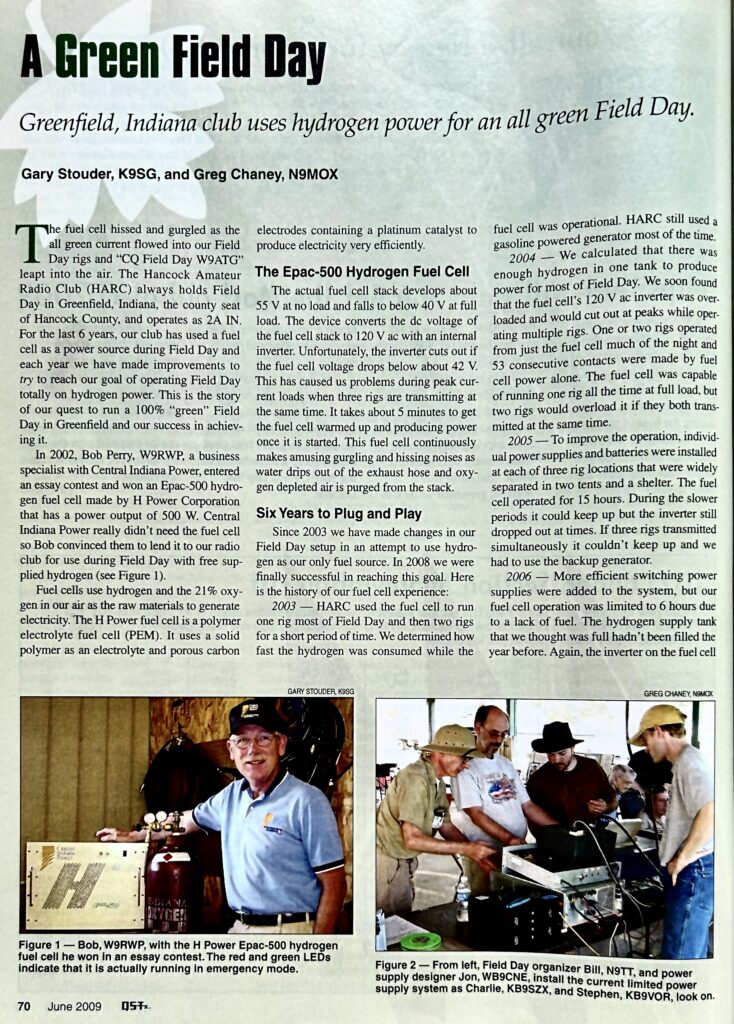
QST ARTICLE (PAGE 2 OF 2)
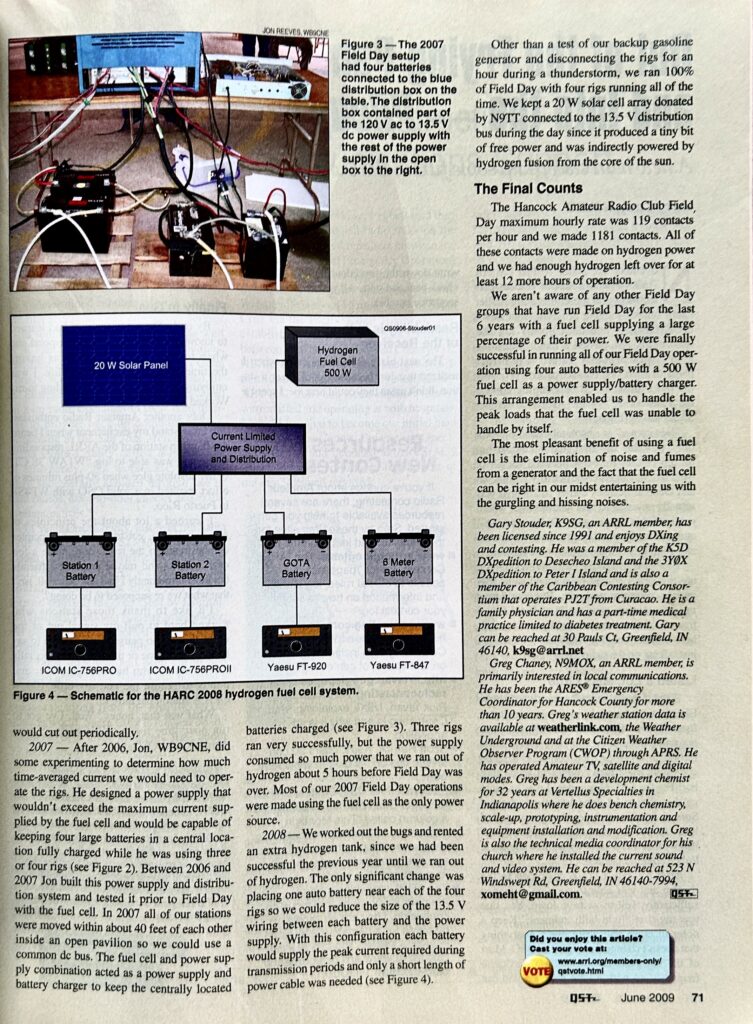
How the Hydrogen Fuel Cell Produced Electricity (not part of published article)
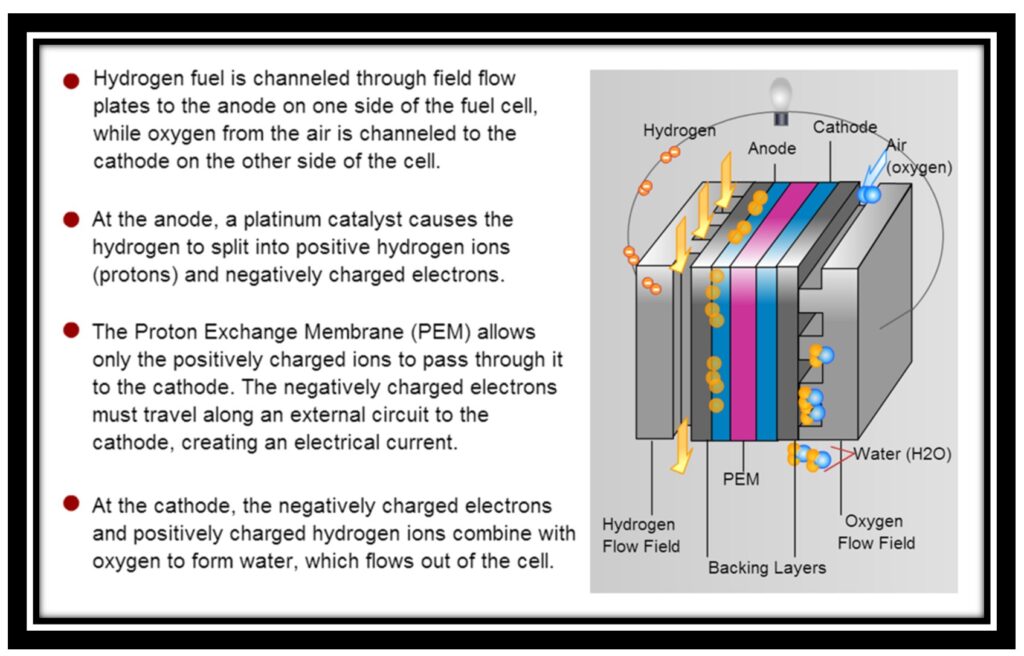
December 2017: Local Ham Radio Operator Rode Out Hurricane Maria
